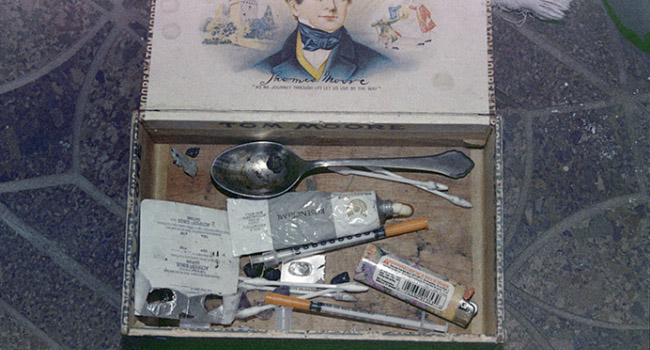Over the weekend, while many of us were involved in some kind of springtime revelry whether motivated by Easter, the equinox, the lunar eclipse or just the general retreat of the winter weather, I enjoyed a fun Saturday night and a lazy Sunday: I played a set at the Melodia Studio open house on Saturday night before heading to Nashville’s downtown art crawl. On Sunday I caught a matinee screening of Things We Do in the Shadows at the Belcourt Theatre. The movie is a mockumentary about a group of vampires sharing a flat in New Zealand. The movie was incredibly funny and I’ll be publishing a proper review in the next issue of The Contributor. At some point on Sunday i was reminded that it was the anniversary of Kurt Cobain’s suicide, but this article on Loudwire spotlights the odd coincidence that finds Cobain sharing the day of his death with another tragic figure from his same grunge rock circles…
Coincidentally, two grunge pioneers died on April 5 — Nirvana frontman Kurt Cobain in 1994, from a self-inflected gunshot wound to the head, and Alice in Chains singer Layne Staley in 2002, from a mix of heroin and cocaine.
Cobain died at the height of Nirvana’s popularity and his demise shook the world in the same way as the violent deaths of presidents and high-profile celebrities like Robin Williams. For many who were in their teens or twenties when Cobain’s body was found in the greenhouse behind his Seattle home, losing the singer of Nirvana was comparable to the death of a parent or other close family member. Millions identified with, and were inspired by the gifted, prolific artist, whose music resonated with equal parts rage, vulnerability and self-hatred.
Ironically, it was that very loathing that made Nirvana’s music so poignant and led to Cobain’s demise. For all the wealth, success and adoration he earned, Cobain was utterly miserable. He felt like he was pulling the wool over the public’s eyes and had become a fraud. We’ll never know whether Cobain killed himself because of his genetic predisposition to depression, his inability to kick heroin, his turbulent marriage to Hole singer Courtney Love, or his contempt at having been labeled the spokesman for a generation when he felt like he couldn’t even understand his own convoluted thoughts. Only one thing is certain. Cobain’s death was no accident, and police have very little reason to believe there was any foul play involved.
In addition, his suicide wasn’t unprecedented. He had been using heroin for years and had overdosed on more than one occasion. On March 1, 1994, Nirvana played a show in Munich, Germany, that turned out to be their final concert. Three days later, he OD’d on Rohypnol and champagne in Rome and spent the next five days in a hospital before flying back to Seattle. The incident is widely believed to have been a suicide attempt.
Like Cobain, Layne Thomas Staley was an integral part of the grunge movement, but became too dependent on heroin to be able to appreciate his importance in the scene. Though Alice in Chains started out as a hair metal band, they quickly tapped into the frustration and self-immolation of the Seattle movement in the ‘90s. The band’s dense, chugging, metallic riffs combined with soaring vocal harmonies reminiscent of Crosby, Stills & Nash defined a new style of grunge that arguably became an even more influential template for hard rock in the years ahead than that constructed by Nirvana.
As the singer for Alice in Chains, Staley was a natural — charismatic, commanding and with a voice that carried all of the power and agility of his heroes, coupled with a self-loathing caused by his insecurity and drug dependency. Staley wasn’t the only member of Alice in Chains who used drugs, but his addiction impaired the band’s ability to tour. Even after AIC released their excellent self-titled third album in 1995, they couldn’t hit the road to support the disc. Three years after it was released, the band performed a set for MTV Unplugged, which was released in July, 1996. Staley’s final performance with Alice in Chains was July 3, 1996, in Kansas City, Mo. — the last of four shows scheduled to support a KISS reunion.
Staley never officially left Alice in Chains. However, gripped by addiction, he became a recluse and, as the years passed, in the words of Neil Young, Staley would “fade away” in the eyes of the public. Guitarist and co-vocalist Jerry Cantrell launched a solo career, but Alice in Chains remained inactive until years after Staley died.
The coincidental connection of the death dates of these two artists is eerie, but likely just that – a coincidence. In the meantime lots of suspicion continues to surround Kurt Cobain’s supposed suicide. Here’s a video that offers lots of insights from Courtney Love’s lawyer regarding her suspicions about the singer’s death.
Stay Awake!
Please subscribe to my YouTube channel where I archive all of the videos I curate at Insomnia. Click here to check out more Music posts








